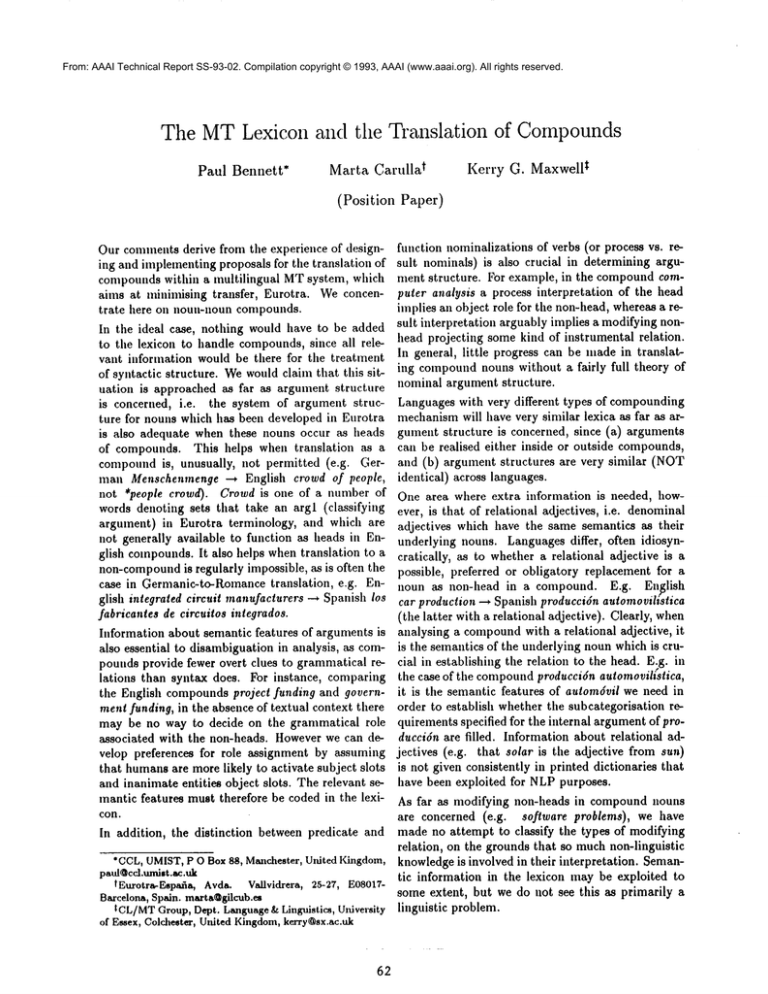
From: AAAI Technical Report SS-93-02. Compilation copyright © 1993, AAAI (www.aaai.org). All rights reserved.
The MTLexicon and the Translation
Paul
Bennett*
tMarta Carulla
(Position
tKerry
of Compounds
G. Maxwell
Paper)
fimction nominalizations of verbs (or process vs. result nominals) is also crucial in determining argument structure. For example, in the compoundcomputer analysis a process interpretation of the head
implies an object role for the non-head, whereas a reIn the ideal case, nothing would have to be added sult interpretation arguably implies a modifying nonto tile lexicon to handle compounds,since all rele- head projecting some kind of instrumental relation.
vant information would be there for tile treatment In general, little progress can be made in translating compoundnouns without a fairly full theory of
of syntactic structure. Wewould claim that this sitnominal argument structure.
uation is approached as far as argmnent structure
Languages with very different types of compounding
is concerned, i.e. the system of argument structure for nouns which has been developed in Eurotra mechanismwill have very similar lexica as far as aris also adequate when these nouns occur as heads gument structure is concerned, since (a) arguments
of compounds. This helps when translation
as a can be realised either inside or outside compounds,
compound is, unusually, not permitted (e.g. Ger- and (b) argument structures are very similar (NOT
identical) across languages.
man Menschenmenge ~ English crowd of people,
not *people crowd). Crowd is one of a number of One area where extra information is needed, howwords denoting sets that take an argl (classifying
ever, is that of relational adjectives, i.e. denominal
argument) in Eurotra terminology, and which are adjectives which have the same semantics as their
not generally available to function as heads in En- underlying nouns. Languages differ, often idiosynglish compounds.It also helps when translation to a cratically, as to whether a relational adjective is a
non-compound
is regularly impossible, as is often the possible, preferred or obligatory replacement for a
case in Germanic-to-Romance translation,
e.g. En- noun as non-head in a compound. E.g. En]glish
glish integrated circuit manufacturers ~ Spanish los car production ---* Spanish produccidn automovilistica
fabricantes de circuitos integrados.
(the latter with a relational adjective). Clearly, when
hfformation about semantic features of arguments is analysing a compoundwith a relational adjective, it
also essential to disambiguation in analysis, as com- is the semantics of the underlying noun which is crupounds provide fewer overt clues to gramnmtieal re- cial in establishing the relation to,the head. E.g. in
lations than syntax does. For instance, comparing the case of the compoundproduccion automovil(stica,
the English compounds project funding and govern- it is the semantic features of automdvil we need in
ment funding, in the absence of textual context there order to establish whether the subcategorisation remay be no way to decide on the grammatical role quirements specified for the internal argumentof proassociated with the non-heads. However we can de- duccidn are filled. Information about relational advelop preferences for role assignment by assuming jectives (e.g. that solar is the adjective from sun)
that humansare more likely to activate subject slots is not given consistently in printed dictionaries that
and inanimate entities object slots. The relevant se- have been exploited for NLPpurposes.
mantic features must therefore be coded in the lexi- As far as modifying non-heads in compound nouns
con.
are concerned (e.g. software problems), we have
In addition, the distinction between predicate and made no attempt to classify the types of modifying
relation, on the grounds that so muchnon-linguistic
*CCL,UMIST,
P O Box88, Maalchester, United Kingdom, knowledgeis involved in their interpretation. Semanpaul@
ccl.umilt.ac .ult
tic information in the lexicon may be exploited to
lEurotra-Espafia, Avda. Vailvidrera, 25-27, EO8017some
extent, but we do not see this as primarily a
Barcelona,Spain. marta@gilcub.es
l CL/MT
Group,Dept. Language&Linguistics, University linguistic problem.
of Essex, Colchester, UnitedKingdom,
kerry@sx.ac.uk
Our commentsderive from tile experience of designing and implementing proposals for the translation of
compounds within a multilingual MTsystem, which
aims at mininfising transfer, Eurotra. Weconcentrate here on nouu-noun compounds.
62



